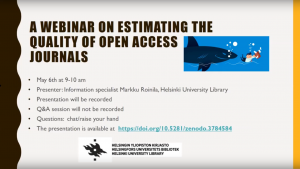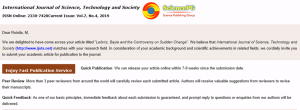The article processing charges (APC) of open access publishing lure in suspicious publishers as well. Therefore it is a good skill for a researcher to recognize the typical characteristics of these so-called predatory publications.
(Tämä artikkeli on saatavilla myös suomeksi.)

This blog post gives you five tips to recognize predatory publications. The tips – and much more – can also be found in a webinar held in the spring, Estimating the Quality of Open Access journals, which is freely available.
In the webinar the typical characteristics of predatory publications (= open access journals where the main incentive is to gain money from researchers by giving uncovered promises) were presented, as well as some advice on how to avoid them.
To cut a long story short, no researcher should publish in predatory journals. Even if it is easy to do (quick publication process and relaxed peer review reports), the APC you pay will be wasted. The journals are unprofessional, their visibility is weak. They are promoted only to collect money and there is no guarantee that the article is published at all. In addition, your reputation as a researcher will suffer if it is known that you publish in a predatory journal.
In what follows, a few rules of thumb are presented to avoid predatory journals. They are discussed at length in the webinar.
1. If the journal does not require APCs, it is not a predatory journal
The whole culture of predatory publishing (and predatory congress organizing) is founded on getting easy money from researchers. If publishing in the journal does not cost you anything (be sure to read carefully all the information in the webpage and the email-offer you received), you can be sure that the journal is non-predatory (although its scientific quality may not be good). It has to be noted that according to some estimates even 75% of open access journals are free of charge for authors (for example, in DOAJ directory there are 11 000 free journals and around 4000 journals which require APCs – the directory is not comprehensive). For example, in Finnish open access journal portal Journal.fi and University of Helsinki’s Editori most journals do not require APCs.
2. If the journal is classified in Publication Forum at least to level 1, it probably is not a predatory journal
In the Publication Forum, maintained by the Federation of Finnish Learned Societies, journals are classified by expert panels to four different categories (0, 1, 2, 3). At level 0 there are publications which are not thought to fullfill the criteria set to scientific publications (as at level 1). This may be because the journal is a trade journal or because it is still so new that the editorial etc. practices of scientific publication are not yet fully established. The level 0 includes also the publications which are judged to be predatory journals. In contrast, the level 1 does not include predatory journals because they do not usually fulfill the strict criteria demanded. Therefore if the journal is classified to at least level 1 in the Publication Forum, you can usually trust it to be a high-quality publication channel. It has to be noted, however, that in level 0 there are quite acceptable publications which do not profess to be scientific research publications.
In addition to Publication forum, another good place to search for quality open access publication channels is Directory of Open Access Journals (DOAJ). The criteria for the journals to be accepted to DOAJ is strict and once the journal is accepted to DOAJ, it probably is no predatory publication. The directory includes search by fields of science and you can also choose between free and APC-journals.
3. If a journal’s peer-review process is very quick or seems artificial, it is probably a predatory journal
Predatory publishers are interested in money instead of advancing scientific researc and therefore the peer-review process is a necessary evil which has to be dealt with minimum time and effort – the process is either a mock-one or non-existent. Very often it is extremely quick, lasting a week at most which is almost unheard of in responsible journals. Typically the article is accepted with minimal revisions or as it is. This is one of the reasons why some proper journals are transferring to open peer-review process.
4. If the journal sends you email-messages and offers constantly, you should be suspicous of its intentions

Predatory publications are very active in presenting their services. For example, after a conference or an article published they often send you a whole lot of offers (like publishing the article you just published or publishing a presentation you gave in a conference). Sometimes the offer concerns a membership in their editorial board.
Be critical of these offers – the responsible journals usually do not need this kind of marketing because they will receive enough manuscripts without asking. So if you are receiving a lot of spam from publishers like Lambert, Science PG or ImedPub, just ignore them or at least check to what level they are classified in the Publication Forum.
5. If the content of the journal is suspicious, it may be a predatory journal

Finally, the most important way to spot a predatory journal is to look at its content. If the articles do not seem to be scientific or are very grandiose, the emphasis in the journal is clearly not the promotion of research. If the field of the journal is very extensive or the name of the journal pompous, this is also suspicious.
If you do not recognize any member of the editorial board or none of your colleagues are aware of the journal, it is best to check it from the Publication Forum, DOAJ or Wikipedia. Most of the predatory publishers are located in India, Africa and other third world countries. It is good to check whether the peer-review process and APCs are presented clearly in the webpage of the journal. It is also worthwhile to check Google or Twitter for discussions of the journal or its publisher.
Finally, if you are still unsure of journal’s credibility, as a researcher at the University of Helsinki, you can always contact the library: openaccess-info@helsinki.fi.
Markku Roinila (TUHAT, ORCID, @Fegster) works as an information specialist at the Helsinki University Library.
